A Comprehensive Literature Review on Occupational Health Nursing
VerifiedAdded on 2023/04/19
|5
|900
|120
Literature Review
AI Summary
This literature review explores the field of occupational health nursing, highlighting its role in business health development and safety programs. It discusses the responsibilities of occupational health nurses, including managing work-related disorders, disaster planning, and coordinating employee treatments. The review also touches upon the significance of nursing epidemiologists in identifying health trends and high-risk populations, as well as the importance of industrial hygiene in preventing workplace stressors. Furthermore, it addresses patient safety concerns within healthcare settings, emphasizing the role of nurses in preventing errors through adherence to principles like the five rights of medication administration. The review cites several sources that provide insights into these critical aspects of occupational health nursing and patient care.
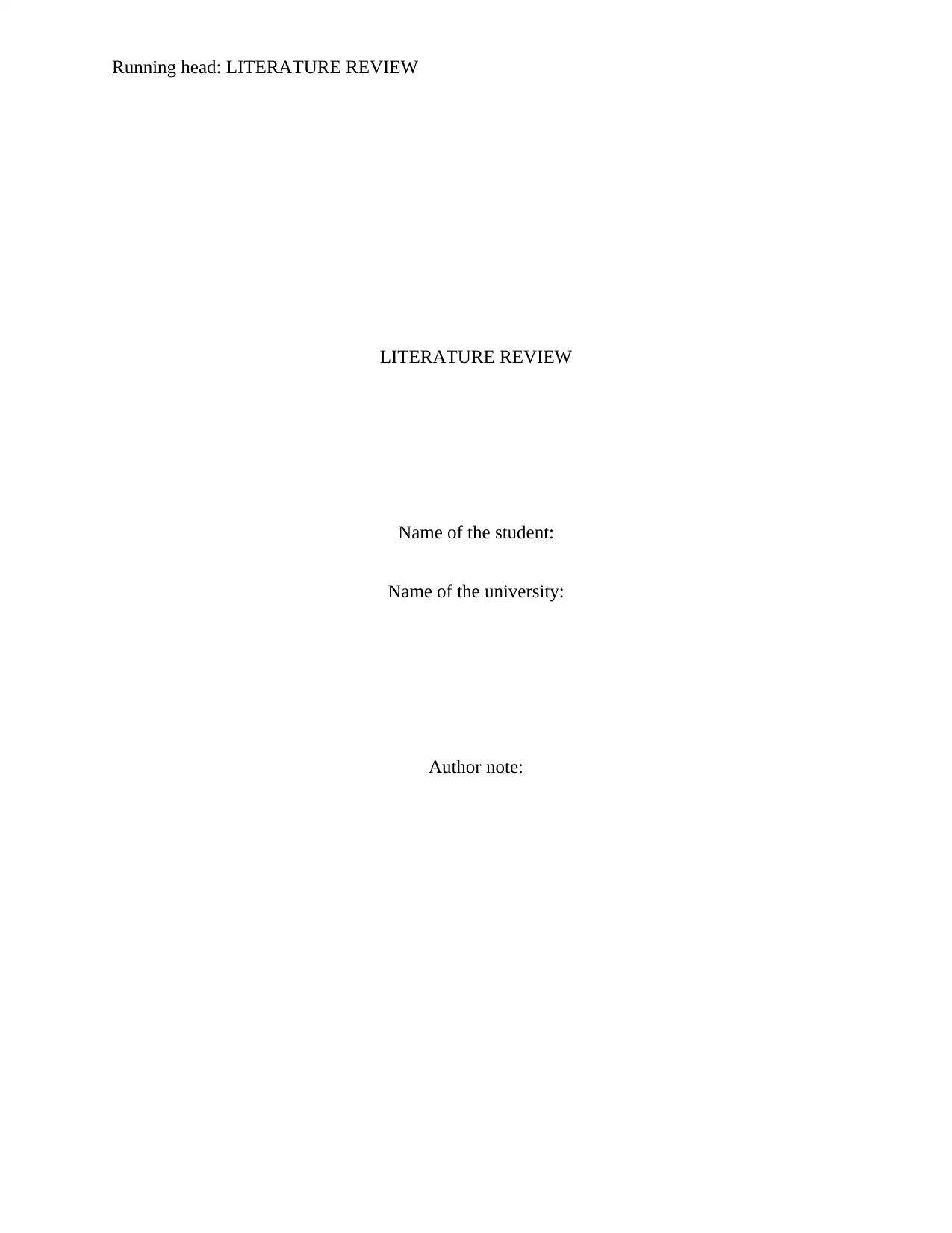
Running head: LITERATURE REVIEW
LITERATURE REVIEW
Name of the student:
Name of the university:
Author note:
LITERATURE REVIEW
Name of the student:
Name of the university:
Author note:
Paraphrase This Document
Need a fresh take? Get an instant paraphrase of this document with our AI Paraphraser
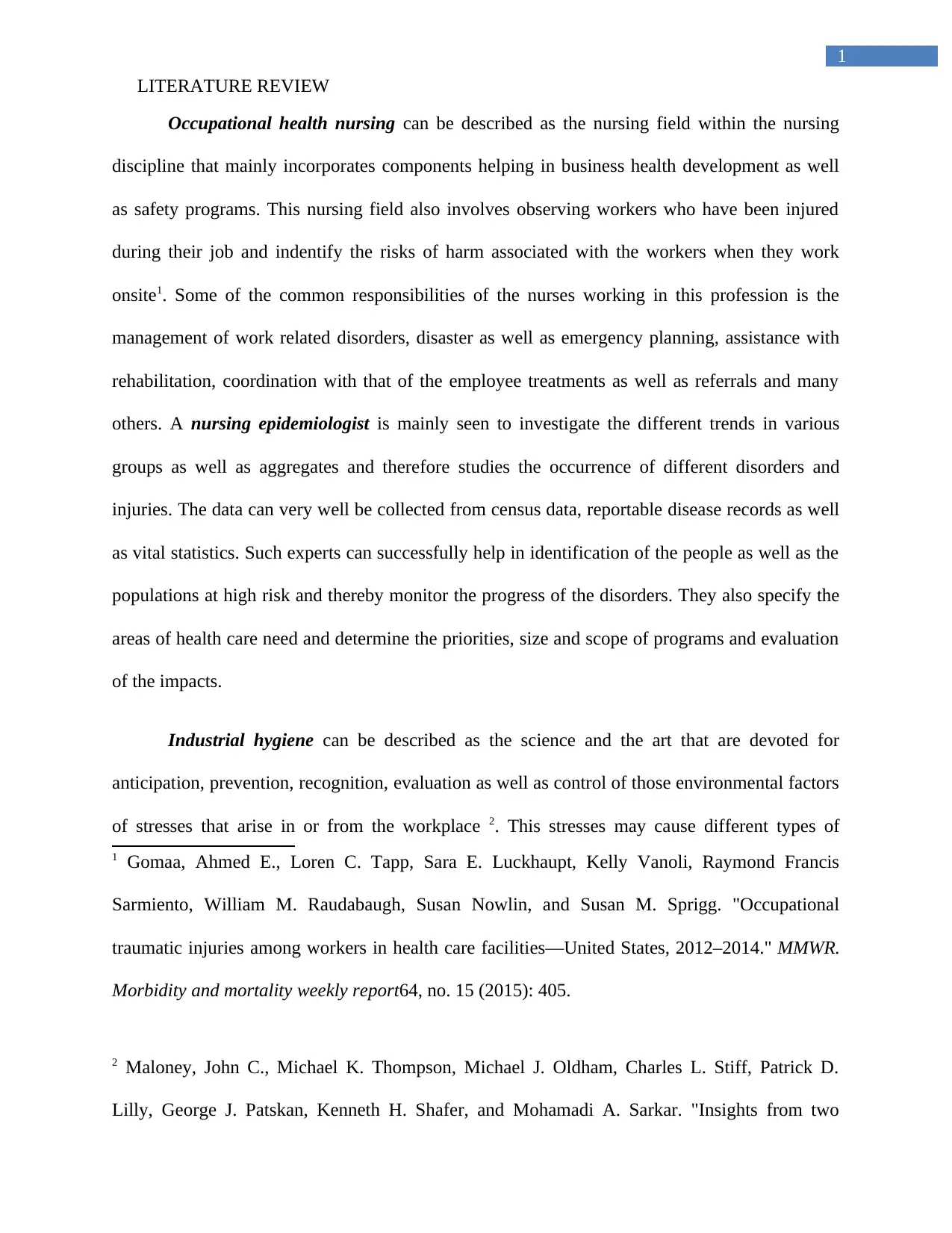
1
LITERATURE REVIEW
Occupational health nursing can be described as the nursing field within the nursing
discipline that mainly incorporates components helping in business health development as well
as safety programs. This nursing field also involves observing workers who have been injured
during their job and indentify the risks of harm associated with the workers when they work
onsite1. Some of the common responsibilities of the nurses working in this profession is the
management of work related disorders, disaster as well as emergency planning, assistance with
rehabilitation, coordination with that of the employee treatments as well as referrals and many
others. A nursing epidemiologist is mainly seen to investigate the different trends in various
groups as well as aggregates and therefore studies the occurrence of different disorders and
injuries. The data can very well be collected from census data, reportable disease records as well
as vital statistics. Such experts can successfully help in identification of the people as well as the
populations at high risk and thereby monitor the progress of the disorders. They also specify the
areas of health care need and determine the priorities, size and scope of programs and evaluation
of the impacts.
Industrial hygiene can be described as the science and the art that are devoted for
anticipation, prevention, recognition, evaluation as well as control of those environmental factors
of stresses that arise in or from the workplace 2. This stresses may cause different types of
1 Gomaa, Ahmed E., Loren C. Tapp, Sara E. Luckhaupt, Kelly Vanoli, Raymond Francis
Sarmiento, William M. Raudabaugh, Susan Nowlin, and Susan M. Sprigg. "Occupational
traumatic injuries among workers in health care facilities—United States, 2012–2014." MMWR.
Morbidity and mortality weekly report64, no. 15 (2015): 405.
2 Maloney, John C., Michael K. Thompson, Michael J. Oldham, Charles L. Stiff, Patrick D.
Lilly, George J. Patskan, Kenneth H. Shafer, and Mohamadi A. Sarkar. "Insights from two
LITERATURE REVIEW
Occupational health nursing can be described as the nursing field within the nursing
discipline that mainly incorporates components helping in business health development as well
as safety programs. This nursing field also involves observing workers who have been injured
during their job and indentify the risks of harm associated with the workers when they work
onsite1. Some of the common responsibilities of the nurses working in this profession is the
management of work related disorders, disaster as well as emergency planning, assistance with
rehabilitation, coordination with that of the employee treatments as well as referrals and many
others. A nursing epidemiologist is mainly seen to investigate the different trends in various
groups as well as aggregates and therefore studies the occurrence of different disorders and
injuries. The data can very well be collected from census data, reportable disease records as well
as vital statistics. Such experts can successfully help in identification of the people as well as the
populations at high risk and thereby monitor the progress of the disorders. They also specify the
areas of health care need and determine the priorities, size and scope of programs and evaluation
of the impacts.
Industrial hygiene can be described as the science and the art that are devoted for
anticipation, prevention, recognition, evaluation as well as control of those environmental factors
of stresses that arise in or from the workplace 2. This stresses may cause different types of
1 Gomaa, Ahmed E., Loren C. Tapp, Sara E. Luckhaupt, Kelly Vanoli, Raymond Francis
Sarmiento, William M. Raudabaugh, Susan Nowlin, and Susan M. Sprigg. "Occupational
traumatic injuries among workers in health care facilities—United States, 2012–2014." MMWR.
Morbidity and mortality weekly report64, no. 15 (2015): 405.
2 Maloney, John C., Michael K. Thompson, Michael J. Oldham, Charles L. Stiff, Patrick D.
Lilly, George J. Patskan, Kenneth H. Shafer, and Mohamadi A. Sarkar. "Insights from two
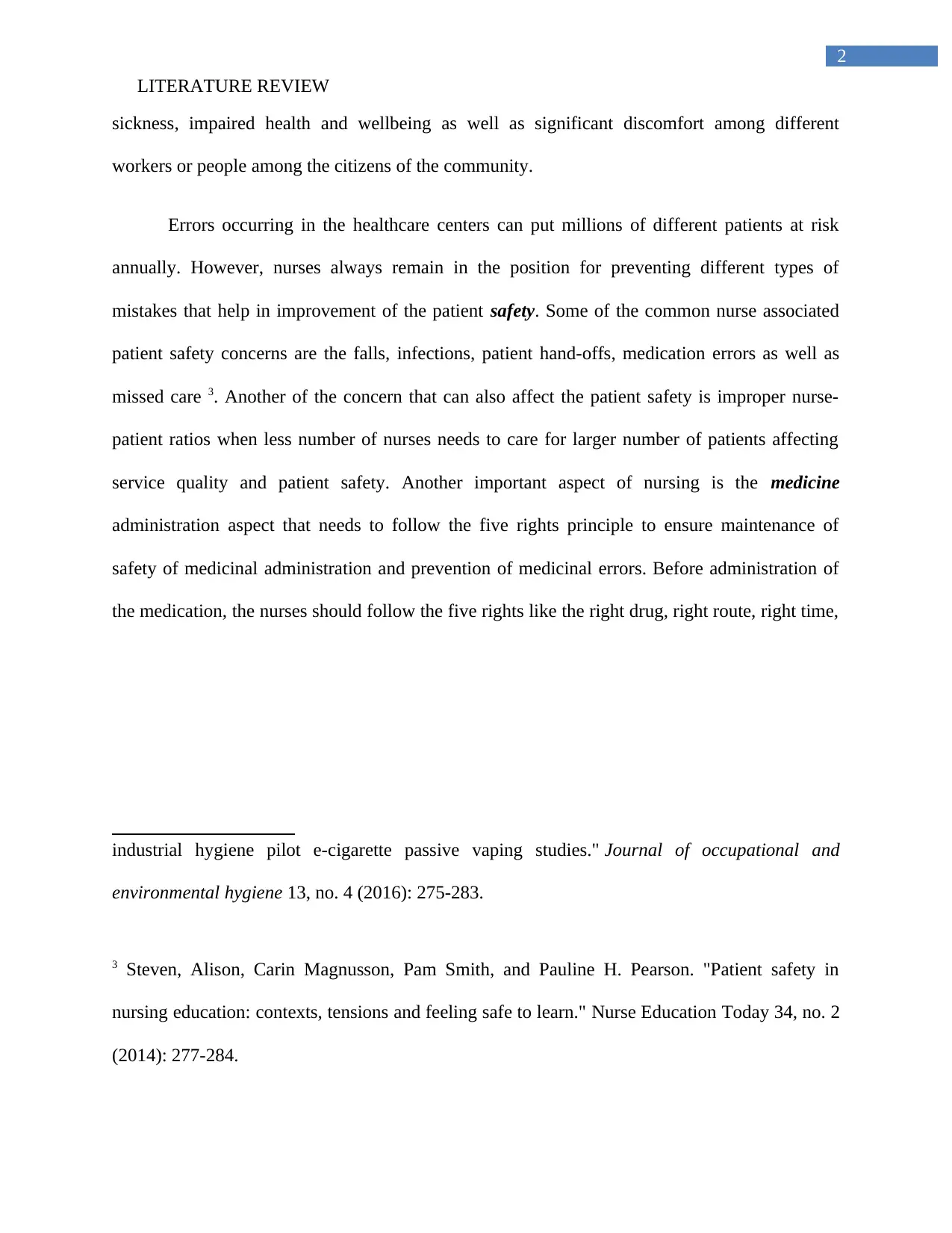
2
LITERATURE REVIEW
sickness, impaired health and wellbeing as well as significant discomfort among different
workers or people among the citizens of the community.
Errors occurring in the healthcare centers can put millions of different patients at risk
annually. However, nurses always remain in the position for preventing different types of
mistakes that help in improvement of the patient safety. Some of the common nurse associated
patient safety concerns are the falls, infections, patient hand-offs, medication errors as well as
missed care 3. Another of the concern that can also affect the patient safety is improper nurse-
patient ratios when less number of nurses needs to care for larger number of patients affecting
service quality and patient safety. Another important aspect of nursing is the medicine
administration aspect that needs to follow the five rights principle to ensure maintenance of
safety of medicinal administration and prevention of medicinal errors. Before administration of
the medication, the nurses should follow the five rights like the right drug, right route, right time,
industrial hygiene pilot e-cigarette passive vaping studies." Journal of occupational and
environmental hygiene 13, no. 4 (2016): 275-283.
3 Steven, Alison, Carin Magnusson, Pam Smith, and Pauline H. Pearson. "Patient safety in
nursing education: contexts, tensions and feeling safe to learn." Nurse Education Today 34, no. 2
(2014): 277-284.
LITERATURE REVIEW
sickness, impaired health and wellbeing as well as significant discomfort among different
workers or people among the citizens of the community.
Errors occurring in the healthcare centers can put millions of different patients at risk
annually. However, nurses always remain in the position for preventing different types of
mistakes that help in improvement of the patient safety. Some of the common nurse associated
patient safety concerns are the falls, infections, patient hand-offs, medication errors as well as
missed care 3. Another of the concern that can also affect the patient safety is improper nurse-
patient ratios when less number of nurses needs to care for larger number of patients affecting
service quality and patient safety. Another important aspect of nursing is the medicine
administration aspect that needs to follow the five rights principle to ensure maintenance of
safety of medicinal administration and prevention of medicinal errors. Before administration of
the medication, the nurses should follow the five rights like the right drug, right route, right time,
industrial hygiene pilot e-cigarette passive vaping studies." Journal of occupational and
environmental hygiene 13, no. 4 (2016): 275-283.
3 Steven, Alison, Carin Magnusson, Pam Smith, and Pauline H. Pearson. "Patient safety in
nursing education: contexts, tensions and feeling safe to learn." Nurse Education Today 34, no. 2
(2014): 277-284.
⊘ This is a preview!⊘
Do you want full access?
Subscribe today to unlock all pages.

Trusted by 1+ million students worldwide
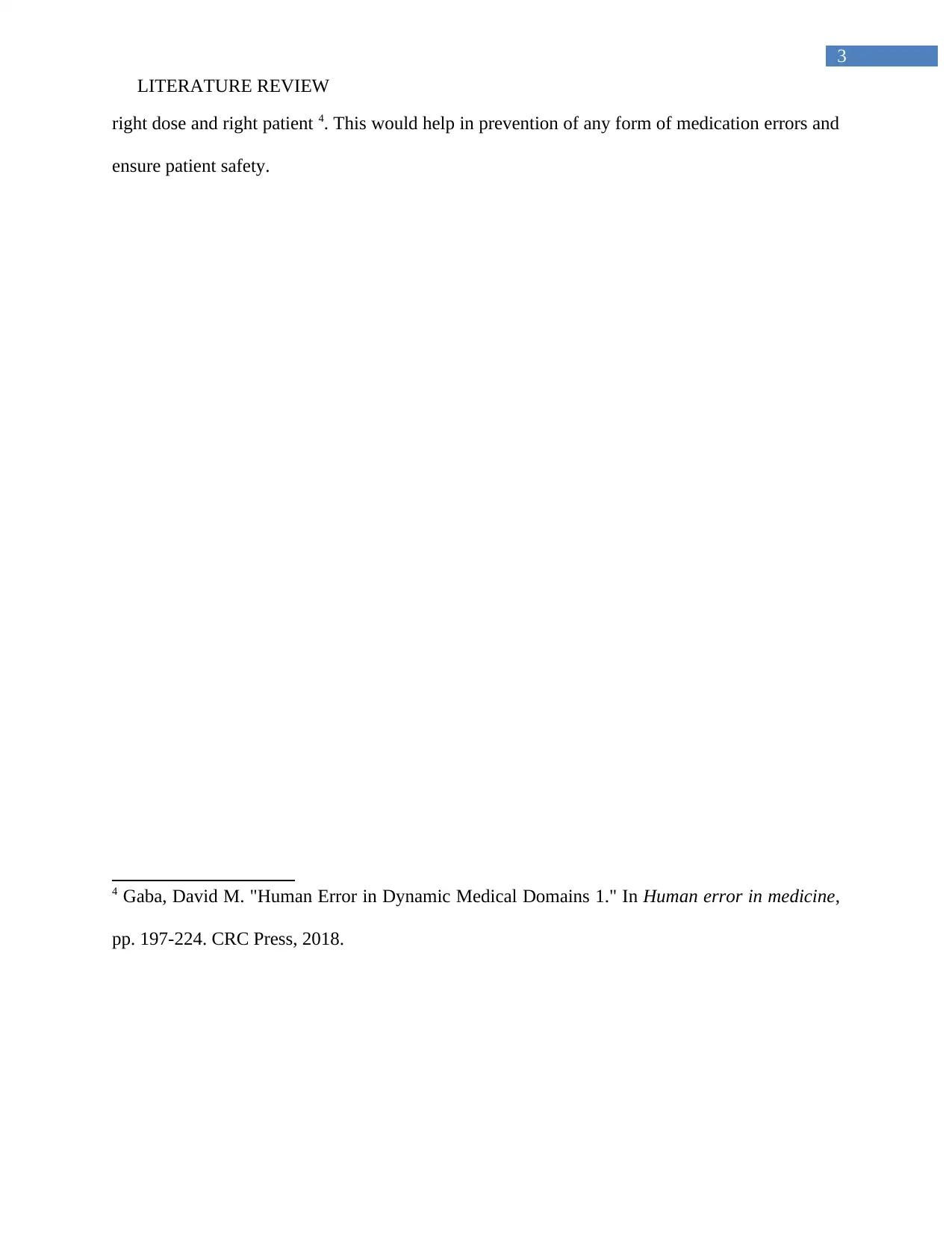
3
LITERATURE REVIEW
right dose and right patient 4. This would help in prevention of any form of medication errors and
ensure patient safety.
4 Gaba, David M. "Human Error in Dynamic Medical Domains 1." In Human error in medicine,
pp. 197-224. CRC Press, 2018.
LITERATURE REVIEW
right dose and right patient 4. This would help in prevention of any form of medication errors and
ensure patient safety.
4 Gaba, David M. "Human Error in Dynamic Medical Domains 1." In Human error in medicine,
pp. 197-224. CRC Press, 2018.
Paraphrase This Document
Need a fresh take? Get an instant paraphrase of this document with our AI Paraphraser
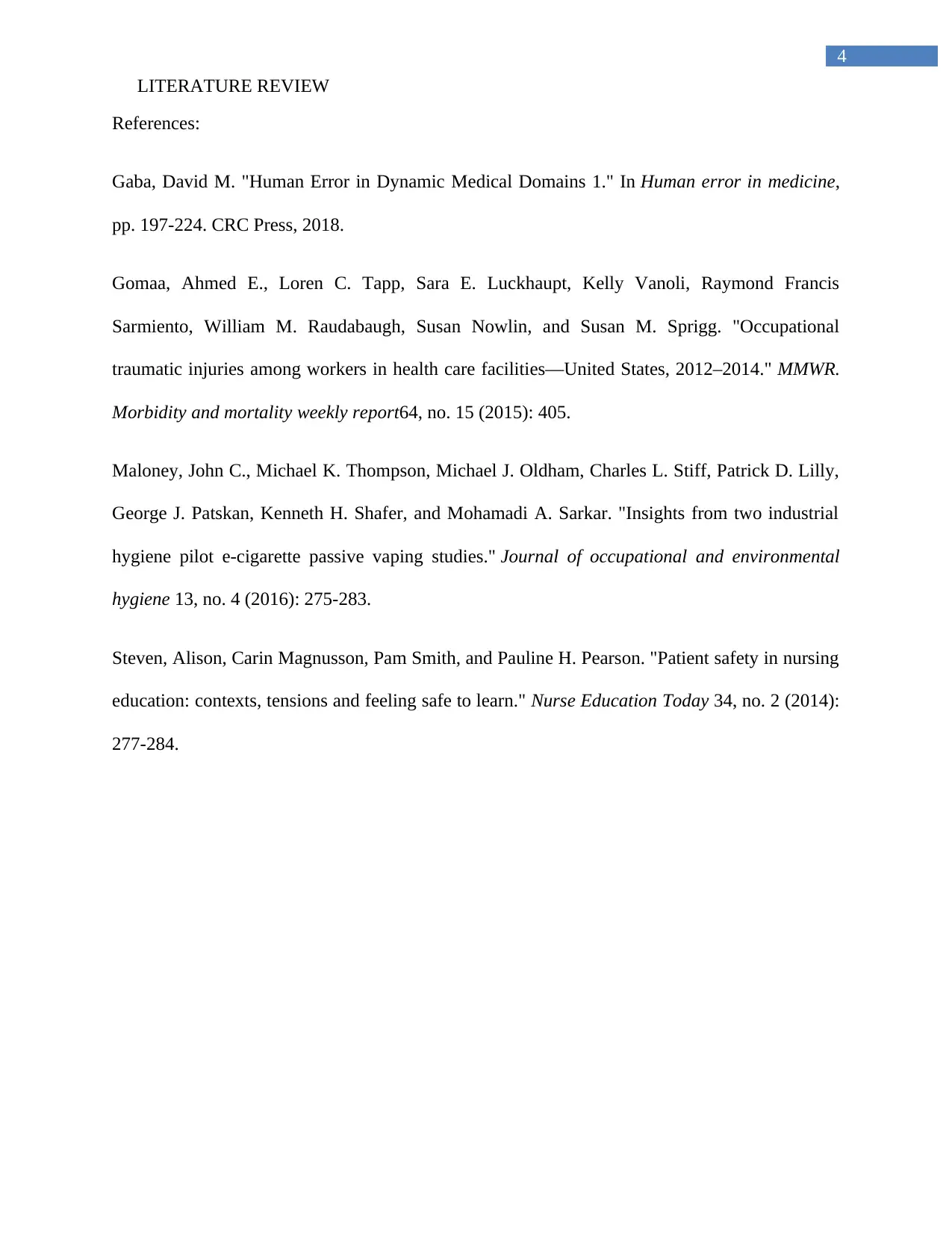
4
LITERATURE REVIEW
References:
Gaba, David M. "Human Error in Dynamic Medical Domains 1." In Human error in medicine,
pp. 197-224. CRC Press, 2018.
Gomaa, Ahmed E., Loren C. Tapp, Sara E. Luckhaupt, Kelly Vanoli, Raymond Francis
Sarmiento, William M. Raudabaugh, Susan Nowlin, and Susan M. Sprigg. "Occupational
traumatic injuries among workers in health care facilities—United States, 2012–2014." MMWR.
Morbidity and mortality weekly report64, no. 15 (2015): 405.
Maloney, John C., Michael K. Thompson, Michael J. Oldham, Charles L. Stiff, Patrick D. Lilly,
George J. Patskan, Kenneth H. Shafer, and Mohamadi A. Sarkar. "Insights from two industrial
hygiene pilot e-cigarette passive vaping studies." Journal of occupational and environmental
hygiene 13, no. 4 (2016): 275-283.
Steven, Alison, Carin Magnusson, Pam Smith, and Pauline H. Pearson. "Patient safety in nursing
education: contexts, tensions and feeling safe to learn." Nurse Education Today 34, no. 2 (2014):
277-284.
LITERATURE REVIEW
References:
Gaba, David M. "Human Error in Dynamic Medical Domains 1." In Human error in medicine,
pp. 197-224. CRC Press, 2018.
Gomaa, Ahmed E., Loren C. Tapp, Sara E. Luckhaupt, Kelly Vanoli, Raymond Francis
Sarmiento, William M. Raudabaugh, Susan Nowlin, and Susan M. Sprigg. "Occupational
traumatic injuries among workers in health care facilities—United States, 2012–2014." MMWR.
Morbidity and mortality weekly report64, no. 15 (2015): 405.
Maloney, John C., Michael K. Thompson, Michael J. Oldham, Charles L. Stiff, Patrick D. Lilly,
George J. Patskan, Kenneth H. Shafer, and Mohamadi A. Sarkar. "Insights from two industrial
hygiene pilot e-cigarette passive vaping studies." Journal of occupational and environmental
hygiene 13, no. 4 (2016): 275-283.
Steven, Alison, Carin Magnusson, Pam Smith, and Pauline H. Pearson. "Patient safety in nursing
education: contexts, tensions and feeling safe to learn." Nurse Education Today 34, no. 2 (2014):
277-284.
1 out of 5
Related Documents
Your All-in-One AI-Powered Toolkit for Academic Success.
+13062052269
info@desklib.com
Available 24*7 on WhatsApp / Email
![[object Object]](/_next/static/media/star-bottom.7253800d.svg)
Unlock your academic potential
Copyright © 2020–2025 A2Z Services. All Rights Reserved. Developed and managed by ZUCOL.





